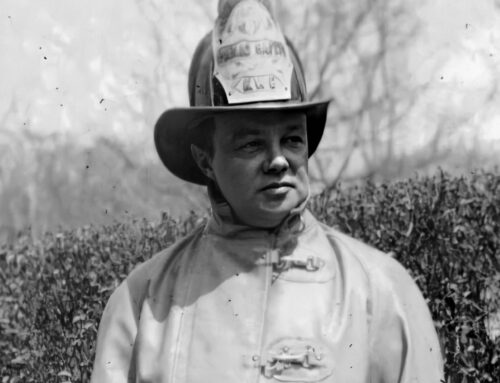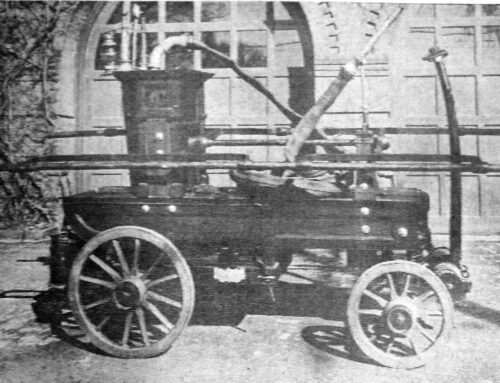This article is dedicated to the numerous hard-working horses of the Stamford Fire Department. They deserve special recognition, often providing a near lifetime of service to the Citizens of Stamford.
- Harry
- Harry (2)
- Dick
- Zoph
- George
- Frank
- Homer
- Jim
- Eagle
- Billy Bo
- The other unnamed Horses

Stamford’s first horse-drawn steam pumper arrived on February 3, 1883. But they had no dedicated horses for it yet. Apparatus of the time were often shuffled between the Luther and Broad Street firehouses for various reasons. Sometimes they were pulled by hand, other times they would borrow horses from local residents to help move the apparatus.
In 1884, the Boroughs Charter was modified to give the Burgesses full control over the Fire Department. So, in 1885, the gradual abolition of the volunteer system began with the appointment of full-time paid firemen in certain positions.
The First Horses of the SFD Arrive
In June of 1885, Van V Lockwoods barn on Luther Street, adjacent to the barn where they were keeping Stamfords first steam fire engine, was prepared for the first horses of the Stamford Fire Department. In August 1885, the Stamford Advocate reported:
“The horses purchased by the borough for use on the steam engine are one of the handsomest teams in town”
August 1885, The Stamford Advocate
In December 1885 a large addition to the Luther St. firehouse was opened and the Broad St. stations were closed. All apparatus and horses were consolidated to what became known as the “Luther Street Fire Station” On December 18, 1885, the Stamford Advocate wrote:
“A very interesting feature of the arrangements and one quite novel here, though familiar enough in the larger cities, is the trained sagacity of the horses in taking the positions on the alarm, without a moment’s delay. The stalls are at either side of the building in the rear, and by pulling an arrangement, something like a bell-handle, near the front door, the partitions (which are really doors) in front of the horses open and both the animals immediately strike a four minute gait for their places at the tongue of the engine. The harnesses, suspended over them, drop to their place and are adjusted in a few seconds. The driver takes a seat and by another bell-handle suspended from the ceiling near his hand, open the front doors and the way is cleared to drive. Mr. McMahon, the man in charge, seems to have had surprising success in training the horses and takes a proper pride in keeping everything under his charge in the best condition for immediate service.”
December 18, 1885, the Stamford Advocate
sagacity: as having or showing keen mental discernment and good judgment; shrewd

On October 19, 1892, the Stamford Advocate reported that the Button Engine was drawn by horses “Harry” and “Dick” for the Anniversary Parade. The new American LaFrance Engine belonging to Engine Company #2 was pulled by a team of four “handsome grays” on loan from H. O. Havemeyer. Two more horses pulled the hose-carriage, and four others pulled the hook and ladder apparatus. It is not clear whether these six other horses belonged to the Department or were also on loan. There is no record of the Department acquiring any additional horses until later in 1898.
In August of 1898, the Stamford Fire Department took ownership of four new horses. The horses assigned to the Hook and Ladder Company of the South End were named Eagle and Billy Bo. The two assigned to the Engine Company were named Zoph and Harry. According to the Advocate:
George is one of the old horses, which has done service in the Department these many years. He understands the business thoroughly and, it is said, can run swifter than any of his mates. When the new horses were purchased, driver George Highland of the Hook and Ladder Company had considerable trouble with them. They were awkward and nervous, but with kind treatment, they were gradually accustomed to the work, and now the horses all respond to the alarms and give encouragement to the unusual proficiency. Zoph and Harry, the engine team, have caused driver Speh considerable trouble. At first, they refused to pull the engine off the floor, but Speh kept at them, and after several hours of practice each day for some time, they understood what was expected of them, and now they start the engine on a jump. The greatest difficulty driver Wilson of the horse carriage appears to have with George is to prevent him from running away when responding to a call. All the roads are level to the old-timer, and the way he makes a corner is wonderful. Wilson has also given up hope of ever being able to control this horse while turning a corner.
AUgust 1898, The Stamford AdvoCate
The four new horses were gray in color and were “stylish” in appearance. They were about “16 hands high” and weighed about 1300 pounds each.
On February 8, 1900, the Stamford Advocate reported that the Chief and City fathers were considering the purchase of three new horses for the new South End Fire Station #2. They took them out for a test run and appeared satisfied with their performance. The article reports that if a price could be agreed upon, the Department would finally have horse-drawn apparatus at the South End Station. On February 15, 1900, the Advocate reported that the three horses were in fact assigned to that station and placed in the charge of Firefighter George Marsden.
According to the 1900 Annual Report, the Department was in possession of eight horses for two steam fire engines, two hose carriages, and one seventy-foot hook and ladder. They were requesting a replacement for “George,” who was slowing down for incidents that were some distance away. He was eighteen years old and had served the Department for twelve of those years.
On February 4, 1904, the Town Hall went up in flames. There was some unspecific Station #2 horse issue that required the horses from Luther Street Fire Station to run down to the South End and haul the Button Steamer to the fire. This caused a significant delay, according to the Advocate.
On March 22, 1904, the Stamford Advocate reported that the South End Station hose-carriage horse “lacks the intelligence necessary” to perform its duty and should be replaced immediately. It is possible that this report is the result of the problems getting equipment to the February Town Hall fire.
A new steam pumper arrived for the No. 2 Station on October 3, 1906. It was a strong Amoskeag. Drawn by three horses, it was destined to become Stamford’s best known steam engine. The Button steamer, going on 24 years old, was put in reserve, to be traded in on a new engine in 1913.
In 1907 the Annual Report, Engine Company No. 2, listed one steam pumper, two hose wagons, and a just-arrived Seagrave combination hook & ladder “city service” truck. The apparatus was manned by 9 firefighters, including the Captain, Engineer of Steamer, drivers and hose men, plus four call men. Six or seven horses were reported in the stalls at that time.
On July 2, 1909, the Stamford Advocate reported that one of the horses assigned to Engine Company #2 was killed in a runaway incident. No specifics were reported.
The End of the Horse Drawn Era Nears
On may 9, 1910, Stamford took delivery of its first motorized apparatus. It was called the Locomobile, but its functionality was that of a Combination Chemical and Hose Car

On August 15, 1911, the gray horse named “Dick” was retired to the Parks Department. Then on April 1, 1912, the black horse named “mike’ was also retired to the Parks Department. Mike served the Department for thirteen years.

In 1913, the Department transferred a 2-horse combination chemical and hose wagon to the South End. To make room for the additional horses, a stairway and some piping in the building were moved, allowing for enough space for the additional stall.
The whole Department was motorizing. All, except the South End station, which instead was becoming a “way-station” for surplus horses. By 1915 the other two Stamford firehouses were completely motorized. In June of 1915, the black horse named Major retired to the Parks Department, having served sixteen years. He was followed a few days later by horses “Doc” and Harry.”
The city traded in its horse-drawn gear as down payments to provide the South End with a new American-LaFrance Combination Truck and a Combination Hose and Pumping Engine.
One question that is always asked concerns how the horse’s name earned their names. The answer is simple… they were generally named to honor various members of the Department. For instance… Eagle was named for Captain George Eagle. Zoph was named for Firefighter Zophar Horton and so forth.




